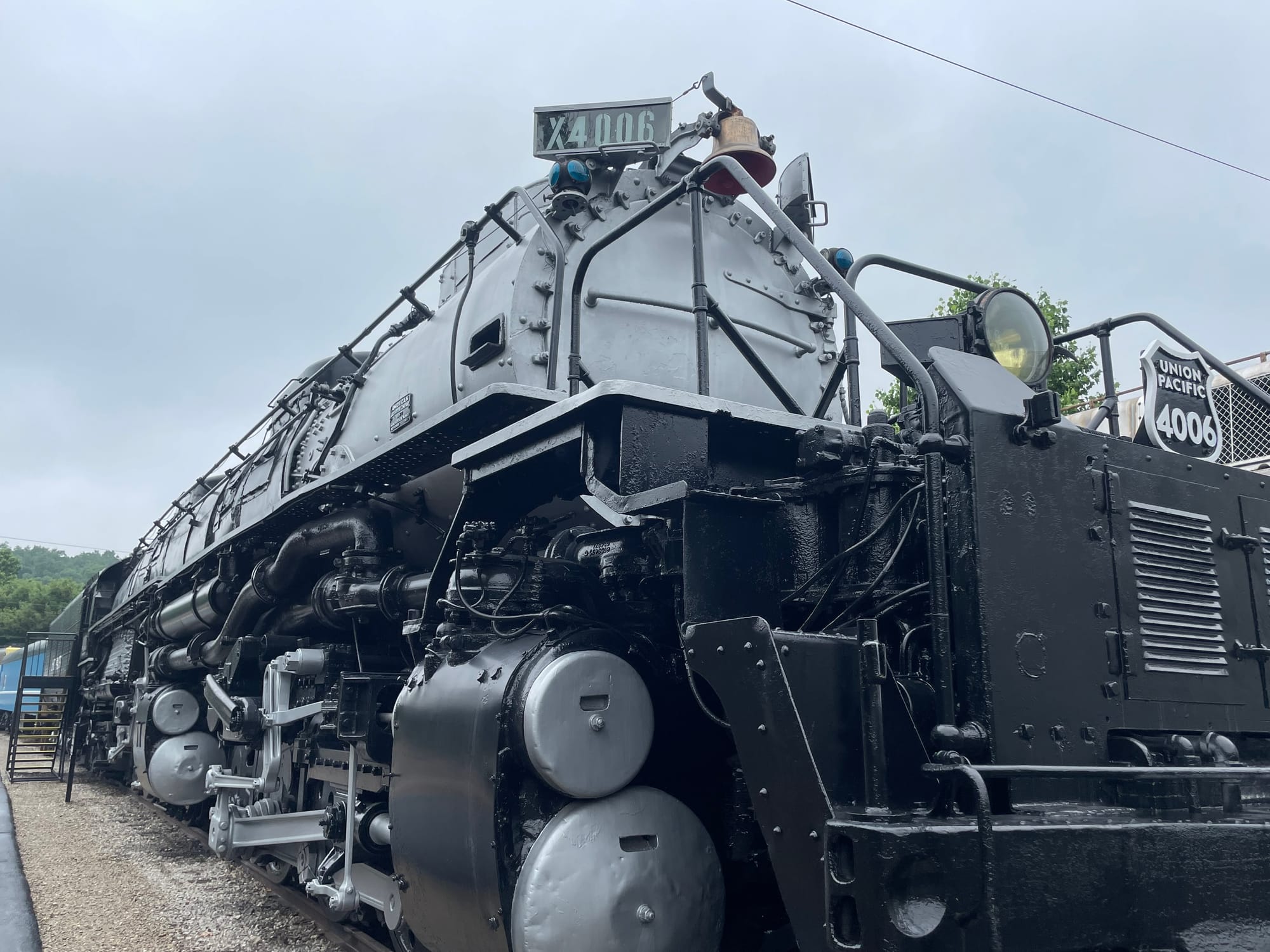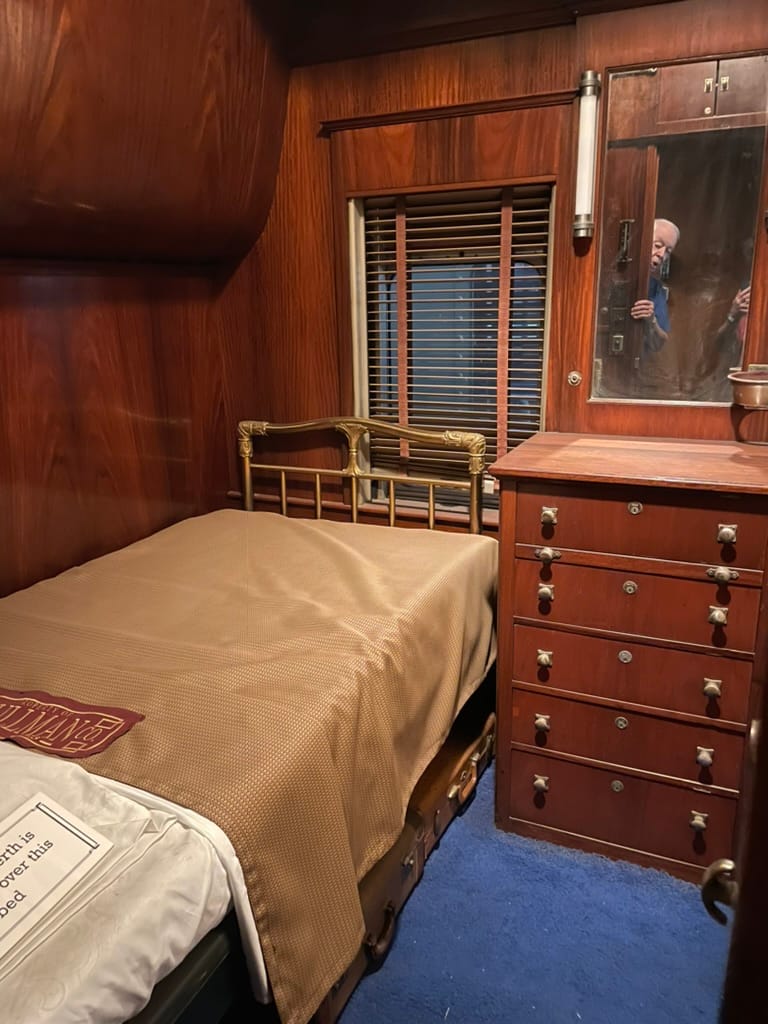Gary and the Three Daves

Friday morning (6/6/2025) I visited the National Museum of Transportation, the resting place of Big Boy #4006. I couldn't pass up the stupid headline, even though I only met two of the Daves, but Dave #2 informed me that there is a Dave #3. (I saw Dave #3, he was working on some grounds keeping.)
This museum holds a special place for me because it's the first train museum I remember going to as a little kid. They have a tank car open at both ends that you can walk through. It's one of my fondest memories, and a reason I love tank cars! They also have a ton of well-preserved steam locomotives. They have one of three remaining examples of Norfolk & Western's Y6 locomotives. 2156 is a "Mallet" type with a 2-8-8-2 wheel arrangement[1]. I didn't get a great pic of the whole thing, sadly:


I have a weird soft spot for the Aero Train too. A great concept (see the Pioneer Zephyr below) but poor execution. (What is it with trying to build trains out of bus bodies?)

I arrived at the museum right at the opening time, hoping to see #4006 and other exhibits before the rain hit. Rain has been a theme this trip so far, which I'll post about later.
When I arrived, there was a group of parents and kids there for an art event, and me. The art event took place inside, so I got to explore the exhibits as the only one on the grounds for almost an hour before I saw other people show up. It was glorious.
I got up close and personal with #4006 right away. You can walk inside, where they have all the controls labeled:


After taking a ton of pictures and video of 4006, I explored the sheds, looking at a long list of other locomotives, I met Dave. I commented I was the only one around, and he suggested I joined him while he checked out some things in normally closed cars. I got my own VIP tour of the Truman presidential car. They have it preserved with the original wood paneling (not recreated), and the stained glass windows.


We also explored a first class Pullman car from the late 1920s. I'm not a nostalgia person (especially being born too late for this era), but I'd love to trade cramped air-travel for an overnight trip to a business meeting in this kind of luxury. Sadly, I didn't take many pictures of the Pullman car as I was too enthralled with Dave's story telling. I did take a pic of the ladies' lounge, where they had special receptacles to put their hair so it wouldn't clog the sinks!

Dave also told me about 4006's preservation efforts. They completed a cosmetic restoration in the last year and the locomotive is complete aside from a missing water pump. The water pump was salvaged three years ago by the crew of 4014 when theirs broke down. #4014 was able to pay a visit to the museum itself. That had to have been really neat.
Despite being intact, there are no plans to restore #4006 to operation. It would need a massive boiler restoration, and there is other age related damage as well. #4006 will remain on display, where you can go see it.
Dave passed me off to Gary, who talked about the Y6 as well as the Pioneer Zephyr train set they have. This was the first stainless steel train, offering lower weight and higher speeds. The sets consisted of integrated power car with storage. A car for baggage, mail (RPO), and coach seating, and a combined coach, observation car. It set speed records between Chicago and Denver in the 30s.

I met Dave #2 in the gift shop. He told me about the museum's small American Flyer model setup. American Flyer was one of the first model train sets. They use AC rather than DC power. Neat little toys. They actually sell a starter set at the museum for $90. That's a great price if someone collects them. (I was very tempted.)
In all: The National Museum of Transportation is a great place. They have an extensive car collect as well. They're planning a big celebration next year for the 100th anniversary of Route 66.
I will see #4012 tomorrow in Scranton, PA, and I hope to provide an update on some of my other travels, including my visit to Horseshoe Curve.
- For the non-nerds, the wheel arrangement numbers refer to the number of leading wheels, driving wheels (the ones with the rods attached to them, to make them go) and trailing wheels on a locomotive. Most locomotives only have one set of drivers, so a 2-8-4 locomotive would be like:
o-OOOO-oo
The Big Boy, and the Y6 have two sets of drivers. Big Boy looks like:oo-OOOO-OOOO-oo